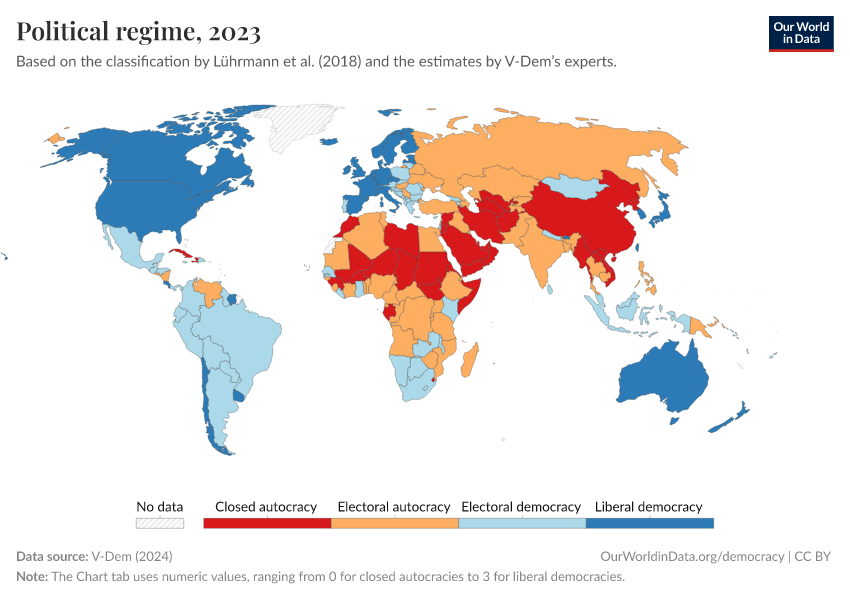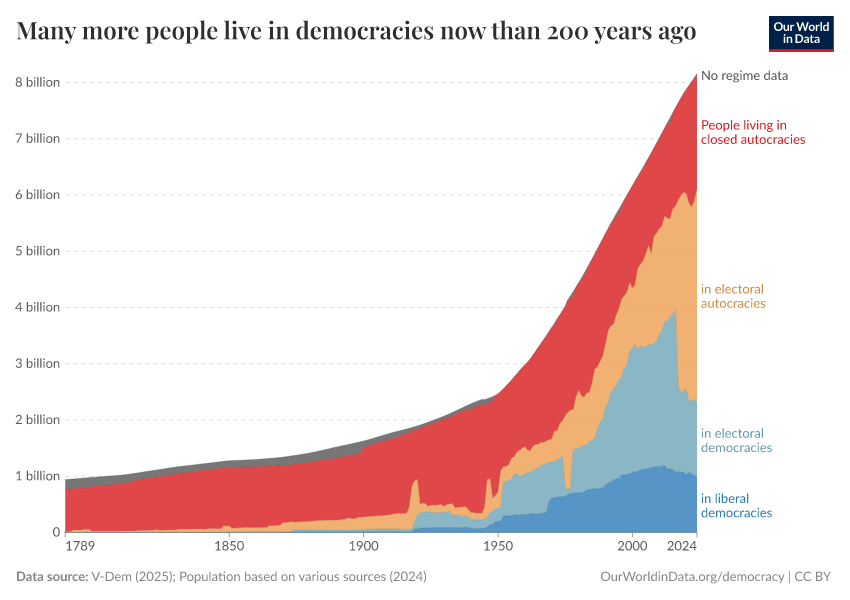200 years ago, everyone lacked democratic rights. Now, billions of people have them
Half of all countries are democracies. But how many people enjoy democratic rights?
When French revolutionaries stormed the Bastille prison in 1789 in pursuit of liberty, equality, and fraternity (and weapons), they could not have imagined how far democratic political rights would have spread a mere 200 years later. In the 19th century, there were few countries one could call democracies. Today, about half of all countries in the world deserve that label.
It is an astonishing achievement that many countries are now governed democratically. But the mere number of countries does not tell us how many people enjoy democratic rights. When Tunisia became democratic in 2012, its population of 11 million gained the political rights that came with it. When India democratized in the 1950s, this same transition affected almost 400 million people.
If we adopt the common and famous understanding of democracy as rule by the people, we should also look at how many people get to have a say in their government. How many people have democratic political rights around the world? And how has their number changed over the last two hundred years?
To answer these questions, we need to combine long-term data on countries' populations1 with information on their political systems. This tells us how the political rights of the world’s population have changed over the past two hundred years.
How do researchers identify which countries are democracies?
Identifying which countries are democracies comes with many challenges. People disagree about what characterizes a democracy, and whether actual political systems can even come close to such an ideal. If they agree on what democracy is and that countries can come meaningfully close to it, its characteristics — such as whether an election is free and fair — still are difficult to assess. If knowledgeable researchers can be found, their assessments are still to some degree subjective, and they may disagree with others. Even if researchers align in their assessment of specific characteristics of a political system, they may disagree about how to reduce the complexity of these many characteristics into a single variable: a binary measure that says whether a country is a ‘democracy’ or not.
Because of these difficulties, classifying political systems is unavoidably controversial.
In our work we therefore rely on sources that work hard to address these many challenges, and are transparent, so that they can be interrogated and criticized by those who disagree.
Here, we identify the political systems of countries with the Regimes of the World (RoW) classification by political scientists Anna Lührmann, Marcus Tannenberg, and Staffan Lindberg.2 The classification uses data from the Varieties of Democracy (V-Dem) project3 and distinguishes between four types of political systems: closed autocracies, electoral autocracies, electoral democracies, and liberal democracies.
Which political systems does the ‘Regimes of the World’ classification distinguish?
- In closed autocracies, citizens do not have the right to choose either the chief executive of the government or the legislature through multi-party elections.
- In electoral autocracies, citizens have the right to choose the chief executive and the legislature through multi-party elections; but they lack some freedoms, such as the freedoms of association or expression, that make the elections meaningful, free, and fair.
- In electoral democracies, citizens have the right to participate in meaningful, free and fair, and multi-party elections.
- In liberal democracies, citizens have further individual and minority rights, are equal before the law, and the actions of the executive are constrained by the legislative and the courts.
While we use RoW’s classification and V-Dem’s data, we expand the years and countries covered and refine the coding rules. This article details how the political systems are measured, which changes we made, and what shortcomings and strengths the measure has. It is important to know that this measure describes when many people in a country had certain political rights, not that everyone had them.4 It is not a perfect classification, but still allows us to approximate how many people have had democratic rights.
Using the RoW classification, the interactive map shows how each country is classified at the end of each year, going back in time as far as 1789. To explore changes over time, you can drag the time-slider below the map.

Almost everyone lacked democratic political rights in the 19th century, but many have gained them since.
In the core chart of this post we see how many people lived under each of the four political systems since 1789. To see what share of the world's population lived in each regime, you can click on the chart and then display relative values under ‘Settings’.
Very few people had democratic political rights in the late 18th and 19th centuries. In 1800, almost everyone lived in regimes that are classified as closed autocracies by RoW. No country was a democracy, and only 22 million people lived in the two countries classified as electoral autocracies: the United Kingdom and the United States.
Most people continued to live in closed autocracies over the course of the 19th century, with 3 out of 4 people still having few political rights by 1900, while those who did not mostly lived in electoral autocracies in the Americas and Western Europe. Only the 14 million people in Australia, Belgium, and Switzerland enjoyed a wide range of electoral and liberal political rights. A further 41 million in France and New Zealand enjoyed many democratic (but not liberal) political rights.
The first half of the 20th century made clear that a spread of democratic rights was both possible and uncertain. Democratic progress in the first decades of the century was set back when countries such as Germany reverted to autocratic rule in the 1930s and 1940s.
Over the course of the second half of the 20th century, large numbers of people then gained democratic political rights. In 1950, almost 220 million people — mostly in Western Europe — lived in liberal democracies, and another 230 million lived in electoral democracies in Western Europe and the Americas. This number increased in the next decades, and by the late 1990s the majority of the world's population — around 3 billion people — lived in electoral and liberal democracies.
The spread of democratic political rights continued during the early 21st century. By 2016, more than 2.8 billion people lived in electoral democracies in all regions of the world: most coming from the populous countries of India,5 Indonesia, Brazil, and Nigeria. Another billion people lived in liberal democracies, such as those living in South Korea and Botswana. Almost all of the 1.8 billion people still living in a closed autocracy now reside in just one country: China.
Democratic political rights are still far from universal — and far from inevitable
While democratic rights have spread far, they are also still far from universal, and there have been recent setbacks. Even though many people now have them, the total number of people not having democratic rights is higher than ever. This is because the world's population grew faster than democracy spread. And some people have recently lost political rights; most prominently the 1.4 billion people living in India, which became an electoral autocracy in 2017.6 This means that now more than two thirds of the world’s population live in closed and electoral autocracies.
These setbacks should serve as a reminder that continued political progress is not inevitable. Nonetheless, we see that a staggering number of people have gained democratic rights in a relatively short period of time. Many people still lack them, but the pace of this progress is a sign that this can change quickly. The French revolutionaries’ — and our — pursuit of liberty, equality, and fraternity is far from over. But we have come a long way already.
Keep reading on Our World in Data
Acknowledgements
I thank Marcus Tannenberg and Johannes von Römer for providing data and code for this article, and the Our World in Data team for feedback.
Endnotes
We identify countries' populations with combined data from Gapminder, the History database of the Global Environment (HYDE) and the United Nations Population Division. Because the data provides annual information and covers virtually all independent countries today as well as many past and present non-sovereign territories, this allows us to cover most of the world’s historical and current population.
Lührmann, Anna, Marcus Tannnberg, and Staffan Lindberg. 2018. Regimes of the World (RoW): Opening New Avenues for the Comparative Study of Political Regimes. Politics and Governance 6(1): 60-77.
Coppedge, Michael, John Gerring, Carl Henrik Knutsen, Staffan I. Lindberg, Jan Teorell, David Altman, Fabio Angiolillo, Michael Bernhard, Agnes Cornell, M. Steven Fish, Linnea Fox, Lisa Gastaldi, Haakon Gjerløw, Adam Glynn, Ana Good God, Sandra Grahn, Allen Hicken, Katrin Kinzelbach, Joshua Krusell, Kyle L. Marquardt, Kelly McMann, Valeriya Mechkova, Juraj Medzihorsky, Natalia Natsika, Anja Neundorf, Pamela Paxton, Daniel Pemstein, Johannes von Römer, Brigitte Seim, Rachel Sigman, Svend-Erik Skaaning, Jeffrey Staton, Aksel Sundström, Marcus Tannenberg, Eitan Tzelgov, Yi-ting Wang, Felix Wiebrecht, Tore Wig, Steven Wilson and Daniel Ziblatt. 2025. "V-Dem [Country-Year/Country-Date] Dataset v15" Varieties of Democracy (V-Dem) Project.
Switzerland gives us one example of this shortcoming. The country has been classified as a liberal democracy since 1849, even though its government forbade women to vote and stand in elections until 1971, more than a hundred years later.
India has since become an electoral autocracy. The next endnote elaborates.
The reclassification is the result of recent changes in the V-Dem data, which identify declines in the autonomy of the election management body, the freedom and fairness of elections, and especially the freedom of expression, the media, and civil society. You can read more in V-Dem’s 2021 annual report Autocratization Turns Viral.
Cite this work
Our articles and data visualizations rely on work from many different people and organizations. When citing this article, please also cite the underlying data sources. This article can be cited as:
Bastian Herre (2021) - “200 years ago, everyone lacked democratic rights. Now, billions of people have them” Published online at OurWorldinData.org. Retrieved from: 'https://archive.ourworldindata.org/20251125-173858/democratic-rights.html' [Online Resource] (archived on November 25, 2025).BibTeX citation
@article{owid-democratic-rights,
author = {Bastian Herre},
title = {200 years ago, everyone lacked democratic rights. Now, billions of people have them},
journal = {Our World in Data},
year = {2021},
note = {https://archive.ourworldindata.org/20251125-173858/democratic-rights.html}
}Reuse this work freely
All visualizations, data, and code produced by Our World in Data are completely open access under the Creative Commons BY license. You have the permission to use, distribute, and reproduce these in any medium, provided the source and authors are credited.
The data produced by third parties and made available by Our World in Data is subject to the license terms from the original third-party authors. We will always indicate the original source of the data in our documentation, so you should always check the license of any such third-party data before use and redistribution.
All of our charts can be embedded in any site.
